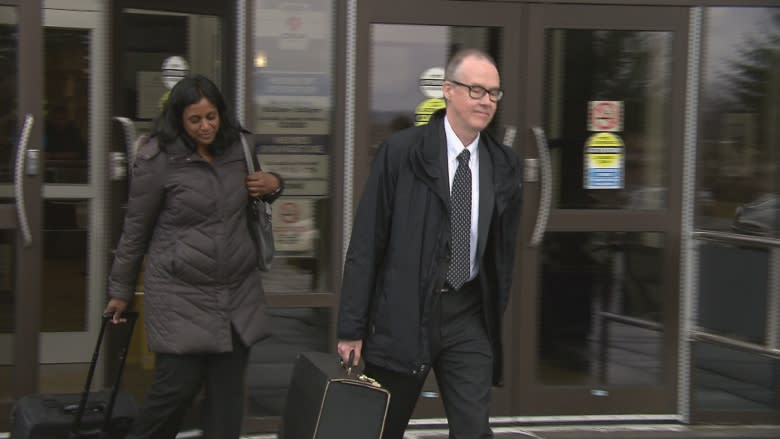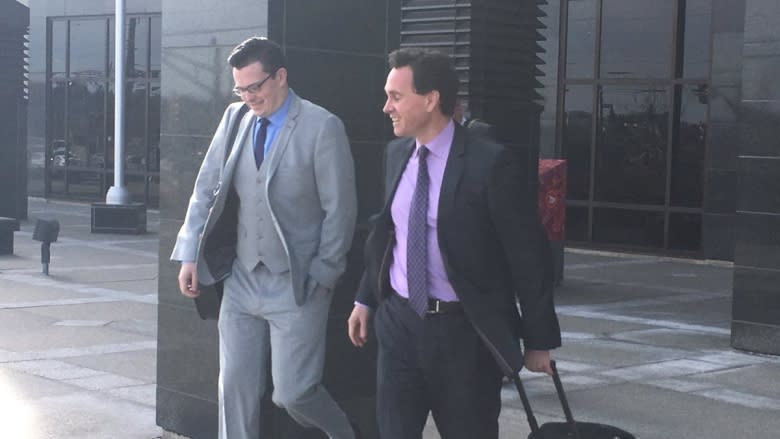Fear of public scrutiny delayed weapon provision, court hears
Fear of public scrutiny guided decisions within the RCMP surrounding carbine deployment, according to a witness at the national police force's labour code trial.
The RCMP is accused of violating health and safety provisions, related to the 2014 shooting deaths of three Moncton Mounties, and wounding of two others.
The Crown is arguing throughout this trial that had officers been equipped with better weapons than the pistols and shotguns they were provided with, they may have been able to counter a better-armed Justin Bourque.
Crown Prosecutor Paul Adams questioned Supt. Bruce Stuart why he felt so many studies — six reports between 2006 and 2011 arriving to the same conclusion — were needed before the carbines could be adopted for frontline officers.
"Who was your audience?" asked Adams. "Who were you trying to justify this to?"
"We wanted to do it right," answered Stuart, explaining the negative media attention the force received after the 2007 killing of a civilian at the hands of police with a Taser gun at the Vancouver airport, and the lack of research done by the force before providing officers with the weapon.
"Where did the priority for ensuring the safety of members come into this equation?" asked Adams, as Stuart continued talking about being able to back up decisions with evidence.
"The need for research wasn't driven by officer safety, it was driven by the need to avoid public scrutiny?" asked Adams. "Is that a fair assessment?"
"Yes," said Stuart, as the Crown indicated it had finished questioning the witness and court adjourned for the day.
Defence tried to show due-diligence
The questions came after the cross-examination of Stuart, a use of force expert who was at the centre of the carbine deployment project for the RCMP, by defence lawyer Ian Carter.
When questioned by the defence, Stuart acknowledged he did not actually recommend carbines be adopted for all frontline officers back in 2006, when he began studying their use. Instead, he had recommended more studies be conducted.
"Because you felt more evidence was needed?" asked Carter.
"I felt superiors needed more evidence to make a decision," Stuart replied.
Carter stressed the importance of research, noting Tasers are non-lethal weapons, whereas carbines are designed to kill.
He suggested Stuart was trying to ensure carbines were adopted in a timely fashion but also that it was done appropriately. Stuart agreed.
Money a factor
Court also heard Wednesday the push to equip RCMP officers with better weapons after four Mounties were killed in Mayerthorpe, Alta., in 2005 was slowed by funding concerns.
Stuart conducted a threat risk assessment — after management finally approved the carbines in 2011— to determine which detachments needed the most patrol carbines, and which needed them the quickest, depending on which regions were most likely to face active shooters.
But somewhere along the way, money became a factor, said Stuart, who explained that different provinces had different means.
"I understand finance plays a piece of it, but to me, don't meld it together."
Stuart said he tried to stress to senior management that officers' lives were at risk.
The force, however, didn't go along with his way of thinking, he said.
The Moncton detachment had no carbines at the time of the 2014 shootings, and no one trained to use them.
"Inevitably, more resources may have helped the matter I guess," he said.
Testimony continues Thursday at the Moncton courthouse with Insp. Troy Lightfoot, Stuart's superior at the time, as the second witness for the Crown.
None of the allegations have been proven in court, and the RCMP has pleaded not guilty to the four violations of the Canadian Labour Code.




